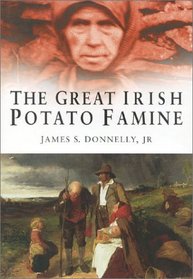While I found this a difficult book to read, I still feel it was profitable.
The difficulty came partially from it being a large, heavy book, about 10 inches tall and 7 inches wide, which made holding it or propping it up to read a bit difficult. And at times it read like a Ph.D. dissertation, which meant it was overly dry in some parts with statistics. There was also considerable repetition of facts. Plus, for some strange reason it was not only printed on glossy paper, which accounts for the weight, but the text was in a light colored print. This meant to read it easily, at least for these old eyes, I had to read it in the right light and at the right angle.
On the other hand the author went to great lengths to present both sides of the Irish famine. While a "revisionist" who believes the British government was not totally responsible for the huge number of deaths, he also shows that British economic policy---the Poor Laws---were. These were the 1840s and people had some interesting ideas of how to handle economic problems. Plus, the frequent changes of the majority party in Parliament caused problems. All this while refuting the idea that "starving the Irish" was government policy.
He also shows that a large emigration from Ireland started before the famine years and continued long after. Irish landholders were divided between those who helped their tennents with reduced rates and often helped pay the way for tennents who wanted to emigrate, and some who could cares less how many died. At least one Irish landholder was murdered. There's more he writes to decry the "facts" offered by those who believed the British wanted to destroy the Irish race, but that's enough for this review.
I especially found it interesting those Irish who emigrated to the U.S. had a higher survival rate, as our U.S. ships were regulated, while British and Canadian shipping wasn't. As a result, the so-called "coffin ships" were mostly those taking emigrants to Canada.
The books also has numerous period photographs, drawings, woodcuts and statistical charts. So many they significantly decrease the pages of text you need read.
The difficulty came partially from it being a large, heavy book, about 10 inches tall and 7 inches wide, which made holding it or propping it up to read a bit difficult. And at times it read like a Ph.D. dissertation, which meant it was overly dry in some parts with statistics. There was also considerable repetition of facts. Plus, for some strange reason it was not only printed on glossy paper, which accounts for the weight, but the text was in a light colored print. This meant to read it easily, at least for these old eyes, I had to read it in the right light and at the right angle.
On the other hand the author went to great lengths to present both sides of the Irish famine. While a "revisionist" who believes the British government was not totally responsible for the huge number of deaths, he also shows that British economic policy---the Poor Laws---were. These were the 1840s and people had some interesting ideas of how to handle economic problems. Plus, the frequent changes of the majority party in Parliament caused problems. All this while refuting the idea that "starving the Irish" was government policy.
He also shows that a large emigration from Ireland started before the famine years and continued long after. Irish landholders were divided between those who helped their tennents with reduced rates and often helped pay the way for tennents who wanted to emigrate, and some who could cares less how many died. At least one Irish landholder was murdered. There's more he writes to decry the "facts" offered by those who believed the British wanted to destroy the Irish race, but that's enough for this review.
I especially found it interesting those Irish who emigrated to the U.S. had a higher survival rate, as our U.S. ships were regulated, while British and Canadian shipping wasn't. As a result, the so-called "coffin ships" were mostly those taking emigrants to Canada.
The books also has numerous period photographs, drawings, woodcuts and statistical charts. So many they significantly decrease the pages of text you need read.




